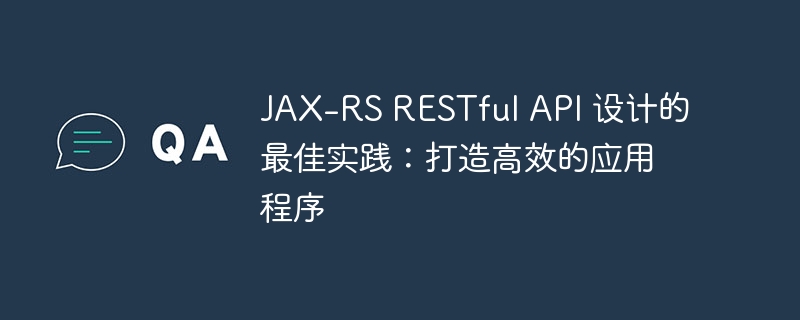

JAX-RS Best practices for RESTful API design: Building efficient applications. RESTful APIs have become an important part of modern application development, and how to design efficient APIs is the focus of developers. This article discusses the best practices of JAX-RS in RESTful API design from a practical perspective, aiming to help developers better create efficient applications. Through the sharing of php editor Banana, let us learn more about how to use JAX-RS to design an excellent RESTful API.
The resource model is the core of the RESTful api and defines the resources available in the application. Best practice recommends using HATEOAS (Hypertext as an Engine for Application State) principles to include links in the response, allowing the client to navigate the application concurrently to reveal other related resources.
@Path("/users")
public class UserResource {
@GET
public List<User> getAllUsers() {
// Fetch users from a database or other data source
return users;
}
@GET
@Path("/{id}")
public User getUserById(@PathParam("id") Long id) {
// Fetch user with the specified ID
return user;
}
}2. Use standard HTTP status codes
Http Status codes provide information about the status of API requests and responses. Using standard status codes (e.g. 200 Success, 404 Not Found) helps clients easily understand the response and handle it appropriately.
@GET
@Path("/{id}")
public Response getUserById(@PathParam("id") Long id) {
User user = userService.findById(id);
if (user != null) {
return Response.ok(user).build();
} else {
return Response.status(404).build();
}
}3. Optimize response processing
Efficient response processing is critical to API performance. Consider using lightweight data formats such as JSON or XML, and paginate the data based on the client's needs. Additionally, enabling gzip compression can reduce response size and increase transfer speed.
@GET
@Produces(MediaType.APPLICATioN_jsON)
public Response getAllUsers() {
List<User> users = userService.getAllUsers();
return Response.ok(users).header("Content-Encoding", "gzip").build();
}4. Implement error handling
Error handling is critical to ensuring the robustness of your application. Create a custom exception class to catch specific errors that occur during API operations and return the appropriate HTTP status code and error message based on the error type.
@GET
@Path("/{id}")
public User getUserById(@PathParam("id") Long id) {
try {
return userService.findById(id);
} catch (UserNotFoundException e) {
throw new WEBApplicationException(404);
}
}5. Use version control
If the API is likely to evolve over time, implementing version control is critical. By using version identifiers in API endpoints, you can easily manage different API versions and ensure backward compatibility.
@Path("/v1/users")
public class UserResourceV1 {
// API implementation for version 1
}
@Path("/v2/users")
public class UserResourceV2 {
// API implementation for version 2
}6. Enable security features
Protecting RESTful APIs from unauthorized access and data tampering is critical. Consider using SSL/TLS encryption, authentication mechanisms (such as Jwt or OAuth 2.0), and rate limiting to enhance API security.
@GET
@Path("/{id}")
@RolesAllowed("ADMIN")
public User getUserById(@PathParam("id") Long id) {
// Only allow authenticated users with ADMIN role to access this endpoint
}7. Provide clear documentation
Detailed API documentation is critical to helping developers understand and use the API. Generate interactive documentation using tools such as the OpenAPI specification or swagger to provide clear descriptions of API endpoints, request and response parameters.
8. Regular review and improvement
It is important to regularly review and improve the design and implementation of RESTful APIs. By collecting user feedback, monitoring API performance metrics, and adopting new technologies, applications can be continuously optimized to meet changing needs.
in conclusion:
Following JAX-RS RESTful API design best practices is critical to creating efficient, maintainable, and user-friendly applications. From resource models to response handling, these guidelines provide comprehensive guidance to help developers build performant and scalable APIs. By continually refining and improving your API design, you can ensure your application stays ahead of the curve in a competitive technology environment.The above is the detailed content of Best Practices for JAX-RS RESTful API Design: Building Efficient Applications. For more information, please follow other related articles on the PHP Chinese website!




